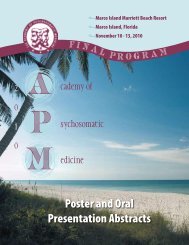Table of Contents - Academy of Psychosomatic Medicine
Table of Contents - Academy of Psychosomatic Medicine
Table of Contents - Academy of Psychosomatic Medicine
You also want an ePaper? Increase the reach of your titles
YUMPU automatically turns print PDFs into web optimized ePapers that Google loves.
Methods: The training is based upon methods developed in<br />
our Communication Skills Training and Research Lab (Comskil<br />
Lab). Training modules and materials were developed<br />
using a process that included a systematic review <strong>of</strong> the<br />
literature <strong>of</strong> CST. Our trainings consisted <strong>of</strong> three 5 hour sessions<br />
focusing on a total <strong>of</strong> six training modules: Responding<br />
to Patient Anger and Communicating with Patients via an<br />
Interpreter (Session 1), Breaking Bad News and Conducting<br />
a Family Meeting (Session 2), and Shared Decision Making<br />
About DNR Orders and The Transition from Curative to<br />
Palliative Care (Session 3). Each module was introduced by<br />
a didactic presentation, which defined the communication<br />
skills to be learned, and exemplary patient interview videos<br />
to demonstrate the skills. Fellows were then divided into<br />
small facilitator-led role plays using actors as standardized<br />
patients. Prior to the training, all fellows were video recorded<br />
doing an initial outpatient consultation. The recordings were<br />
coded to indicate which specific communication skills the<br />
fellows used and written feedback was sent to the fellows.<br />
Post-training recordings were also done and coded to determine<br />
uptake <strong>of</strong> skills.<br />
Results: Previous results <strong>of</strong> Comskil trainings <strong>of</strong> medicaloncology<br />
fellows have demonstrated increased usage <strong>of</strong><br />
skills particularly in the “establish the framework <strong>of</strong> the consultation”<br />
and “empathic communication” categories. We will<br />
present outcomes <strong>of</strong> CST among <strong>Psychosomatic</strong> <strong>Medicine</strong><br />
fellows.<br />
Conclusion: CST is an effective and innovative method for<br />
addressing one <strong>of</strong> the core competencies <strong>of</strong> <strong>Psychosomatic</strong><br />
<strong>Medicine</strong> fellowship training.<br />
References:<br />
1. Brown RF, Bylund CL: Communications skills training: Describing<br />
a new conceptual model. Acad Med. 2008; 83:37-44<br />
2. Bylund C, Brown RF: Oncologists participation in a comprehensive<br />
communication curriculum: assessment <strong>of</strong> skills<br />
uptake using the Comskil coding system. Psycho-oncology.<br />
2008; 17(6 Suppl): S164<br />
GROUP B<br />
5. Predictors <strong>of</strong> Posttraumatic Stress<br />
Disorder and Return to Usual Major Activity<br />
in Traumatically Injured Intensive Care Unit<br />
Survivors<br />
Presenting Author: Dimitry Davydow, MD<br />
Co-Authors: Douglas Zatzick, MD, Frederick Rivara, MD,<br />
MPH, Gregory Jurkovich, MD, Jin Wang, PhD, Peter Roy-<br />
Byrne, MD, Wayne Katon, MD, FAPM, Catherine Hough,<br />
MD, Erin Kross, MD, Ming-Yu Fan, PhD, Jutta Joesch, PhD,<br />
Ellen Mackenzie, PhD<br />
Objective: This study aimed to assess intensive care unit<br />
(ICU) and acute care service-delivery characteristics as well<br />
as pre-ICU factors as predictors <strong>of</strong> posttraumatic stress disorder<br />
(PTSD) and return to usual major activity after ICU admission<br />
for traumatic injury.<br />
39<br />
Method: Data from the National Study on the Costs and<br />
Outcomes <strong>of</strong> Trauma was used to evaluate a prospective<br />
cohort <strong>of</strong> 1,906 ICU survivors at 69 United States hospitals.<br />
We assessed PTSD with the PTSD Checklist. Regression<br />
analyses ascertained associations between ICU and<br />
acute care service-delivery characteristics, pre-ICU factors,<br />
early post-ICU distress, and 12-month PTSD and return to<br />
usual activity, while controlling for clinical and demographic<br />
characteristics.<br />
Results: Approximately 25% <strong>of</strong> ICU survivors had symptoms<br />
suggestive <strong>of</strong> PTSD. Higher levels <strong>of</strong> early post-ICU distress<br />
predicted both PTSD and limitations in return to usual major<br />
activity. Pulmonary artery catheter insertion (Risk Ratio (RR)<br />
1.28, 95% Confidence Interval (95%CI) (1.05-1.57), p=0.01)<br />
and pre-ICU depression (RR 1.23, 95%CI (1.02-1.49),<br />
p=0.03) were associated with 12-month PTSD. Longer ICU<br />
lengths <strong>of</strong> stay (RR 1.21, 95%CI (1.03-1.44), p=0.02) and<br />
tracheostomy (RR 1.29, 95%CI (1.05-1.59), p=0.01) were<br />
associated with diminished usual activity. Greater numbers<br />
<strong>of</strong> pre-existing medical co-morbidities were associated with<br />
both PTSD and limitations in return to usual activity.<br />
Conclusions: Easily identifiable risk factors including ICU/<br />
acute care service-delivery characteristics and early post-<br />
ICU distress were associated with an increased risk <strong>of</strong> PTSD<br />
and limitations in return to usual major activity. Future investigations<br />
could develop early screening interventions in acute<br />
care settings targeting these risk factors, facilitating appropriate<br />
treatments.<br />
6. Five-Factor Model Personality as Predictors<br />
<strong>of</strong> Incident Coronary Heart Disease in the<br />
Community: A 10.5 Year Prospective Cohort<br />
Study<br />
Presenting Author: Hochang Lee, MD<br />
Co-Authors: Oscar Bienvenu, MD, PhD, Daniel Ford, MD,<br />
MPH, Christine Ramsey, BS, William Eaton, PhD, Gerald<br />
Nestadt, MBBS<br />
Objective: Certain personality and behavioral traits (e.g.<br />
Type A, and Type D) and depression have been reported<br />
to be associated with cardiac morbidity and mortality in the<br />
community. However, few have examined the putative relationship<br />
based a comprehensive assessment <strong>of</strong> personality<br />
along with a structured assessment <strong>of</strong> psychiatric disorders.<br />
Based on the Baltimore ECA follow-up Study and the Hopkins<br />
Epidemiology <strong>of</strong> Personality Study, We examined five<br />
major domains <strong>of</strong> personality traits (neuroticism, extroversion,<br />
openness, agreeableness, and conscientiousness) and<br />
incident coronary heart disease (CHD) event (defined as<br />
myocardial infarction, angioplasty, or coronary artery bypass<br />
surgery).<br />
Design and Setting: A 10.5 -year prospective, communitybased<br />
cohort study.<br />
Participants: 614 community residents (age: 45.4 +/- 10.9;<br />
female: 64.7%).<br />
Measurements: Between wave 3(1993-6) and wave 4<br />
(2004), each participant responded to the 240 item NEO



